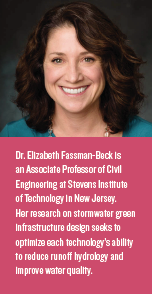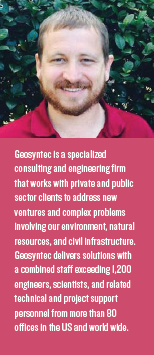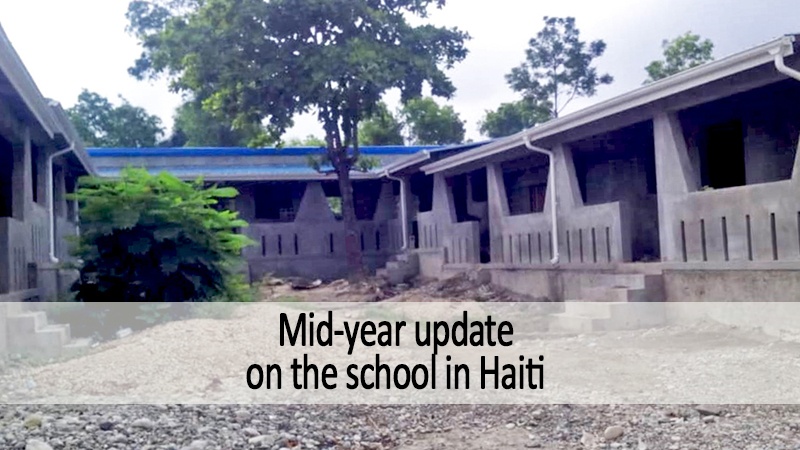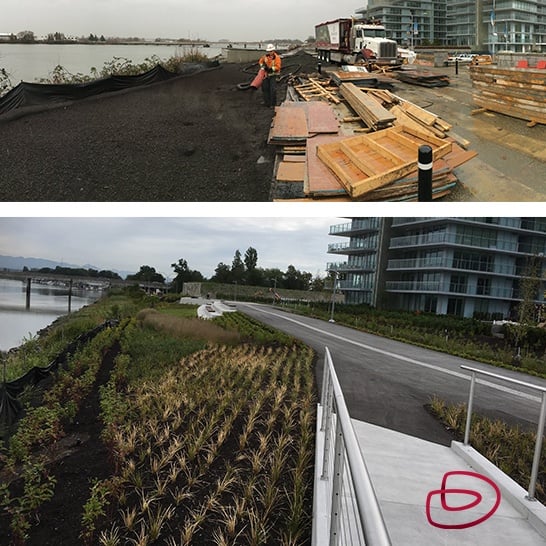ON THE ROOF WITH... ELIZABETH FASSMAN-BECK, PHD., STEVENS INSTITUTE OF TECHNOLOGY AND MIKE HARDIN, PHD., PE, CFM, WATER RESOURCES ENGINEER FOR GEOSYNTEC CONSULTANTS
Interview by Steven W. Peck, GRP, Honorary ASLA
Civil engineers who work in the field of stormwater management are facing considerable challenges, from regulatory
agencies who are adopting green infrastructure approaches to extreme weather events that are challenging baseline assumptions.
This winter, I caught up with Elizabeth Fassman Beck, who teaches at Stevens Institute of Technology in Hoboken, NJ and is the Chair of the Environment & Water Resources Institute, Urban Water Resources Research Committee’s Green Roof Task Committee and Mike Hardin, of Geosyntec to ask some tough questions about the practice.
1. In your opinion, how has civil engineering practice around stormwater management changed over the past ten years?
EFB: Stormwater infrastructure design objectives are usually dictated by regulation. Historically, regulatory compliance has been met with large, centralized facilities designed to reduce flooding, stream erosion (theoretically), and property damage from reasonably larger, infrequent events, and to provide water quality treatment (removal) of particulate-bound pollutants. By now, we know that designing stormwater systems
to address only these objectives falls very short of protecting our receiving environments and communities.
Using technologies like stormwater green infrastructure (GI), and overall approaches like low impact development (LID), we should be minimizing runoff generation, trying to keep runoff and pollutants out of the sewers with small scale controls at or near the sources, and incorporating methods to minimize discharge of a wide range of pollutant forms. Maximizing natural hydrologic processes like infiltration and evapotranspiration and promoting stormwater harvesting and reuse are essential elements. Designing these functions to handle flows from smaller, day-to-day size storm events is critical. Where we see wide-scale implementation of these ideas is where regulation has changed. Unfortunately, regulation remains the driver, and change is the exception rather than the rule. We have the technology. We need policies to catch up and enable advancement. 
MH: In regard to stormwater management, I think there are still plenty of traditional grey infrastructure projects, but I am seeing more green infrastructure projects, specifically, water quality improvement projects to remove nutrients from stormwater driven by total maximum daily loads (TMDLs), and NPDES permit requirements. More recently, the areas of resiliency and sea level rise have been given a lot of attention, especially for coastal communities. This is resulting in more modeling of extreme storm events and municipalities looking to make their stormwater infrastructure more robust and resistant to the effects of weather changes and sea level rise.
2. We keep reading about extreme weather events all over the world? How, if at all, is the profession dealing with the 'new normal' in terms of weather and climate?
EFB: In my opinion, dealing with extreme weather events is still predominantly addressed in a reactionary way. Looking forward, design resilience and redundancy is the key.
MH: Being from Florida, this is very much a reality for the engineering community. I am starting to see more municipalities looking at long-term modeling and planning projects that assess the current state of drainage infrastructure and examine the resiliency based on different climate projections. Additionally, municipalities are looking to model more extreme storm events in their floodplain modeling to understand the potential impacts of a changing climate. This information is used to prioritize infrastructure upgrades in watershed wide planning.
3. Green infrastructure is increasingly being recognized as a complementary approach to addressing stormwater issues on new and existing buildings and sites. How well are civil engineers adapting to these changes?
EFB: Civil Engineers (CE) that have opportunities to learn how different GI technologies work tend to be very receptive! Among the challenges we face in broader scale adoption include:
- Implementation of nearly all stormwater management projects is driven by regulation and/or development policy. In many cases, regulations and policy have not kept pace with research or practical observation. In some cases, existing policies actually hinder adoption of GI solutions.
- In the bigger picture of infrastructure, GI is very new. There is a strong need for technical training of the existing design and construction industry. However, without clients or regulatory services demanding GI, there is little incentive to allocate resources to new training.
- Stormwater design integrates knowledge from several different topics within Civil Engineering. From a curriculum perspective, CE courses in stormwater design are most likely offered at the graduate level. Undergraduate curricula in CE are strongly dictated by accreditation, which means that many undergraduates simply don’t get the opportunity to enroll, if there is even a course offered.

MH: Based on my experiences, I think civil engineers are adapting and supporting green infrastructure (GI). Typically, local building codes are the biggest impediment to more wide-spread use. I have seen some municipalities go as far as rewriting their building codes to remove impediments to GI as well as incentivize the use of GI by allowing designers to take credit for green space requirements, as an example. I believe the GI will continue to gain in popularity, particularly in urban areas where space is limited, and cost of land prohibits building large stormwater ponds or other large footprint BMPs.
4. Engineering is very liability sensitive. Are there some types of green infrastructure that are currently better accepted by civil engineers than others, and if so why?
EFB: To some extent I think preference is given to some GI techniques over others based on perceptions of construction and maintenance costs. I use the word perception specifically. For example, self-mitigating runoff controls like permeable pavement and green roofs do cost more to build compared to a conventional pavement or rooftop – if all you’re considering is the cost of the road or the roof. This kind of silo-accounting omits the cost of building an otherwise required downstream stormwater control that occupies more land, needs catch basins and buried pipes to convey runoff to it … and all of that infrastructure also requires long-term maintenance.
Dismissal of permeable pavement because of maintenance perceptions suggest poor understanding of appropriate site selection. Likewise, excellent stormwater control in many climates can be achieved with shallow-depth, reasonably low weight green roofs if materials and plants are appropriately specified.
MH: I think rain gardens and bio-swales are the most accepted GI. They are relatively low risk and low cost. The
maintenance of these systems is well understood by the engineering community and easy to relate to municipal or
regulatory enforcement personnel. It should also be noted that municipalities struggle with ensuring that the final property owner performs the necessary maintenance to keep GI performing properly, making them more likely to encourage simpler systems that they are more familiar with in case they need to provide some training to get
the GI operating properly.
5. What are the pros and cons, from your perspective, of using green roofs to meet stormwater management
requirements?
EFB: The primary advantage of a green roof is that it is a self-mitigating surface with respect to stormwater. Green roofs prevent runoff generation, or minimize it to a trickle, for the majority of day-to-day storm events. They can be effective even in winter, with dormant plants. If there is no runoff, there is no problem. Among all other stormwater management tools, green roofs offer more ancilliary benefits. Where designed appropriately, we can provide amenity space, habitat, and reduce energy demand at the site-scale.
MH: There are several pros but the big one is turning a stormwater generator into a stormwater sink. Implementation of green roofs allows for more developable or revenue generating land or minimizing the amount of land needed to meet stormwater management requirements. This is especially true if a cistern or other water storage is used in conjunction with green roofs to capture and reuse green roof runoff, which frequently results in a significant water quality benefit due to the significant volume reductions. The biggest cons are the initial cost of green roofs, building code impediments, and lack of an in-depth understanding of the technology in the
general engineering community.
6. There are some green roof configurations that are more like blue/green roofs, designed to retain more water than typical systems? What do you think are the most promising new approaches to building-based stormwater management?
EFB: On-site runoff management provides the most technically effective opportunities for minimizing stormwater impacts to the environment and infrastructure.
MH: I think that blue/green roof projects that incorporate stormwater and grey water capture and reuse are the most fascinating and promising approaches to whole building water management. As fresh water supplies continue to be stressed, designs will more and more need to manage water in a more holistic fashion to preserve supplies. I see blue/green roofs, stormwater harvesting, and grey water reuse as being integral to this process.
7. Which models are best able to address the contribution green roofs make to stormwater management and why?
EFB: Stormwater regulations carry quantitative objectives. Civil engineers must be able to calculate runoff quantities and quality under a variety of scenarios. Of utmost importance is to accurately quantify the effect of a green roof, and to be able to integrate that calculation into the context of the whole site (i.e. not just the building footprint), or possibly a whole catchment or sewershed.
Flow processes through an engineered green roof (and many other green infrastructure systems) are very complicated. Unfortunately, current design guidance offered by many regulatory agencies either neglects calculation instruction altogether, or offers very simplified approaches which are akin to a bucket filling up and emptying or overflowing. This approach neglects the dynamic operation of a green roof, and tends to underestimate
performance.
The US Environmental Protection Agency’s Stormwater Management Model (SWMM), is the only model of which I am aware that specifically incorporates calculation routines that might accurately represent green infrastructure technologies. I say “might” because its accuracy hasn’t been widely tested (yet) against observed data. SWMM can be applied at any scale – from a single building to an entire watershed. SWMM also offers the benefit of being an open-source, publicly available model. We’re working on generating field performance data that can evaluate SWMM’s accuracy for a variety of green infrastructure technologies.
MH: Green roofs in Florida typically require irrigation during the dry season. Additionally, to provide a water quality benefit, it may be necessary to capture and reuse green roof runoff. For this reason, when designing green roofs in Florida, it is recommended to provide some water storage to capture this runoff. To effectively size the cistern a long term, 10 years or greater of precipitation data, continuous simulation model is recommended. There are many software programs available to perform this modeling such as EPA SWMM, ICPR, or even using Microsoft Excel.
8. Are you aware of any developments coming down the pipe that will either strengthen or weaken the use of green infrastructure, and if so what are they?
EFB: At the moment, major investments in green infrastructure are occurring across the USA in order to comply with regulations, and avoid potential massive environmental fines, by reducing the frequency and volume of combined sewer overflows (CSOs). In cities like New York and Philadelphia, investments are anticipated at over US$1B. This isn’t a problem unique to large cities though. The US EPA indicates that most communities with CSO problems
have fewer than 10,000 people. Widespread stormwater GI implementation has been shown to be a critical contributor to technically achieving the required level of runoff mitigation.
MH: I would say resiliency and sea-level rise might be an ally to the green roof industry. This is because green roofs can reduce runoff at a given site without additional footprint. In a future where stormwater attenuation and storage will be harder to find, green roofs might offer a solution in space limited urban areas.
Source: 2018 Stormwater Issue of the Living Architecture Monitor Published by Green Roofs for Healthy Cities




